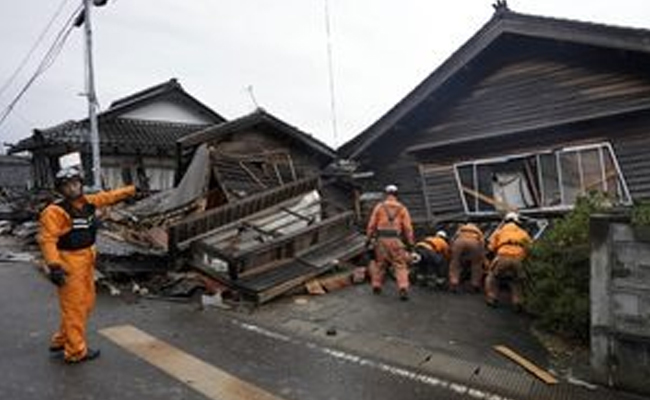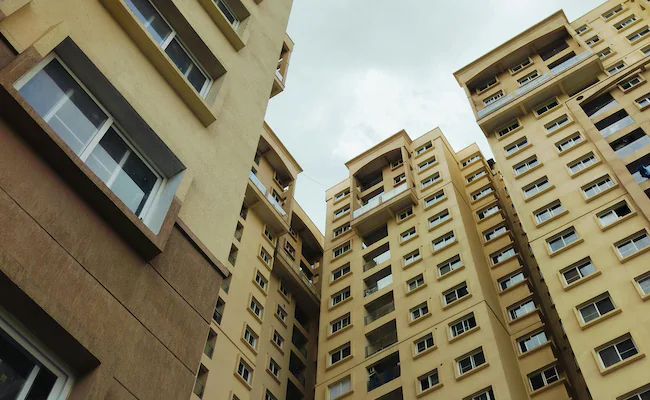Wajima (AP): A woman was pulled carefully from the rubble 72 hours after a series of powerful quakes started rattling Japan's western coast.
Despite rescue efforts, the death toll on Friday grew to at least 94 people, and the number of missing was lowered to 222 after it shot up the previous day.
An older man was found alive on Wednesday in a collapsed home in Suzu, one of the hardest-hit cities in Ishikawa Prefecture. His daughter called out, "Dad, dad," as a flock of firefighters got him out on a stretcher, praising him for holding on for so long after Monday's 7.6 magnitude earthquake.
Others were forced to wait while rescuers searched for loved ones.
Ishikawa officials said 55 of those who died were in the city of Wajima and 23 were in Suzu, while the others were reported in five neighbouring towns. More than 460 people have been injured, at least 24 seriously.
The Earthquake Research Institute at the University of Tokyo found that the sandy coastline in western Japan shifted by up to 250 metres seaward in some places.
The earthquakes set off a large fire in the town of Wajima, as well as tsunamis and landslides in the region. With some routes cut off by the destruction, worries grew about communities in which water, food, blankets and medicine had yet to arrive.
The United States announced USD 100,000 in aid on Friday, including blankets, water and medical supplies, and promised more help would come. Dodgers major leaguer Shohei Ohtani also announced aid for the Noto area, though he did not disclose the amount.
Thousands of Japanese troops have joined the effort to reach the hardest-hit spots on the Noto Peninsula, the centre of the quake, connected by a narrow land strip to the rest of the main island of Honshu.
Experts warned of disease and even death at the evacuation centres that now house about 34,000 people who lost their homes, many of them older.
Masashi Tomari, a 67-year-old oyster farmer who lives in Anamizu city in Ishikawa, said it was tough sleeping on the floor with just one blanket. There was no heating until two stoves finally arrived Thursday three days after the 7.6 quake struck.
"This is a terrible, cold place," he said.
Tomari felt at a loss thinking about his home, where broken glass and knocked over items littered the floor. It was pitch dark at night because the area was still out of power.
But Tomari and others were already thinking about rebuilding.
Sachiko Kato, who owns a clothing shop in Anamizu, put up a yellow notice as a warning inside her store where the walls have tipped slanted, and a red one for the shed in the back that was completely flattened.
"So many stores were on this street. Now, they're all gone. Maybe we can work hard to rebuild," she said.
As of Friday, running water was not fully restored in Anamizu. Kato had to get water from a nearby river to flush the toilet.
Dozens of aftershocks have rattled Ishikawa and the neighbouring region in the past week. Japan, with its crisscrossing fault lines, is an extremely quake-prone nation. Weather forecasts called for rain and snow over the weekend, and experts warned of more aftershocks.
The region affected by the latest quakes is famous for its craftwork, including lacquerware, knives, ceramics, candles and kimono fabric.
Tsutomu Ishikawa, who oversees a resin company called Aras that makes fashionable plates and cups, said no lives were lost around him, but the atelier was seriously damaged.
He apologised for delayed deliveries and expressed determination to pick up and rebuild, while acknowledging the challenges. "We are feeling a deep helplessness that works we created with so much love are gone."
Sachiko Takagi, who owns a kimono shop on a street lined with picturesque stores in Wajima, said she was lucky her 80-year-old store inherited over generations was still standing. Others were not so lucky.
"These people do not have the energy to start something from scratch," she said. "I really wonder what will happen to this street."
Let the Truth be known. If you read VB and like VB, please be a VB Supporter and Help us deliver the Truth to one and all.
Jabalpur: Anju Bhargava, vice-president of BJP's Jabalpur city unit, has come under sharp scrutiny, creating the ripples of political controvery in Madhya Pradesh, after a video surfaced online showing her physically assaulting a visually impaired woman inside a church.
The New Indian Express has reported that the said incident reportedly took place on Saturday (20 Dec) at a church in the Hawa Bagh area, which comes under the limits of Gorakhpur police station.
The video footage that has circulated widely on Monday shows Anju Bhargava, assaulting the blind woman in the presence of a police officer. In the video, Bhargava is seen shouting at the woman, twisting her arm and forcibly grabbing her face. The victim can be heard pleading to Bhargava to speak to her rather than resorting to physical violence. Also, we can hear Bhargava screaming, “will be blind in her next birth too”
ALSO READ: Woman arrested for theft, stolen gold articles worth Rs 32 lakh seized
According to The Indian Express reports, Bhargava entered the church, with members of several Hindutva affiliated organisations, alleging that the visually impaired children were being forced into religious conversion; But, the students present at the church have flatly denied all the allegations.
An unnamed police officer cited in media reports states that there was no evidence to support claims of forced religious conversion. The incident has since intensified political debate in the state, with opposition parties demanding accountability and action against those involved.





